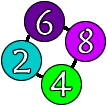
Category: Number Concepts, Number Operations, and Patterns
Suitable for Grade Level: Elementary and Secondary
The Math in this Problem:
In this math puzzle, students will experiment with number sequences and patterns, using single digits. More particularly, arithmetic sequences are the number patterns investigated here. Students will gain an understanding of common number patterns and a foundation for branching off to more complicated, related topics, such as geometric and special sequences.
When a grain of sand finds its way into a clam or other mollusk and becomes an irritant. The mollusk responds to the irritating grain by covering it with nacre, the same material that their shells are made of. After repeatedly adding layers of nacre, the mollusks have produced a pearl. Pearls differ in shape, size and colour.

One day a group of 10 clam divers found that they had each collected 10 pearls. These they numbered based on their colour.

Amazingly, there were exactly 10 pearls of each colour.
By coincidence, on that very same day, a mathematician wandering from A to B, took a wrong turn and stumbled into the village of the clam divers and their 100 new pearls. “These pearls are wonderful!” said the mathematician. “They should be made into a beautiful bracelet!”
“We were just enjoying them as pearls” said one of the soft-spoken clam divers.
“Nonsense, pearls are made for stringing together!” said the mathematician as he sat down at a table. “Let me show you how.”
- Pick a first and second pearl. They can be the same number, or not.
- To get the third pearl, add the numbers on the first and second pearls. If the sum is more than 9, just use the last (ones) digit of the sum.
- To get the next pearl, add the numbers on the last two pearls you used, and use only the ones digit.
- Keep going until you get back to the first and second pearls, in that order.
- Tie them in a loop to make a bracelet! (Don’t use the last two pearls since they just repeat the first two pearls)
The clam divers looked at each other, silently bemused at this strange man.
“I think you need an example” said the mathematician.
- Say I chose 2 and 6 for the first and second pearls

- The third pearl is 2 + 6 = 8

- to get the fourth pearl, add 6 and 8, then use only the ones digit: 6 + 8 = 14; use 4

- 8 + 4 = 12; use 2

- 4 + 2 = 6

- The last two pearls are the same as the first two, so remove them and make a bracelet by tying the rest of them in a clockwise loop.

“That is how to make a pearl bracelet!” said the mathematician triumphantly.
The pearl divers were not so sure that they liked this mathematician. After all, how many pearls had he dived for? How many times had he cut his hands on sharp coral? How many times had he held his breath till it hurt? But they listened to him graciously.
- “So what sizes of bracelet can I make?” the mathematician said absentmindedly as if lost in calculations.
- “Will a bracelet always loop back to the beginning??”
- “How many different starting pairs of pearls are there???”
- “If I start with the same two pearls, but in the opposite order, do I get the same bracelet? Do I get the same bracelet in reverse????”
- “How many different bracelets are there?????”
Suddenly, the mathematician slumped on the table. It had been a tiring day. The oyster divers looked at each other, “What a strange, irritating man” they agreed. They wrapped the mathematician in a hammock, and by the time he woke up, the clam divers had answered all his questions.
Extensions:
Each day, the mathematician would ask more irritating questions, and each night the clam divers would wrap him up and put him to bed and have them solved by morning. Once the mathematician asked:
- In base 12, guess which is the longest and shortest bracelet among those starting with “22”, “33”, “44”, “55” and “66”????
Josh and James from Bishop Pinkham calculated all possible base 10 bracelets without writing a computer program! Show that the bracelet that starts “64” is the same as the bracelet which starts “88”.
